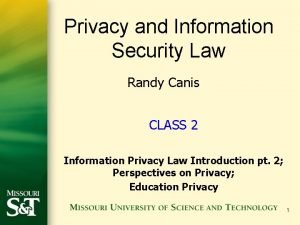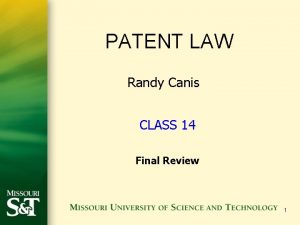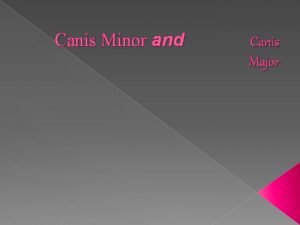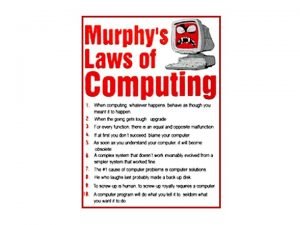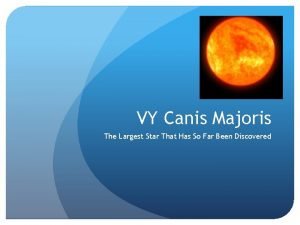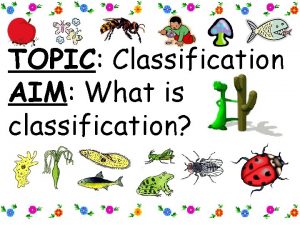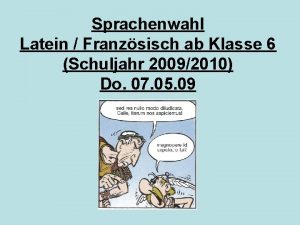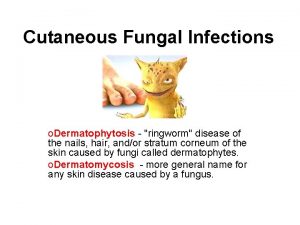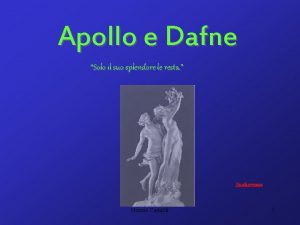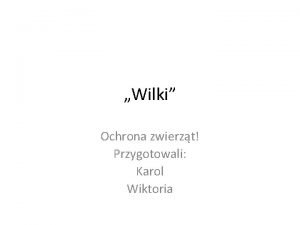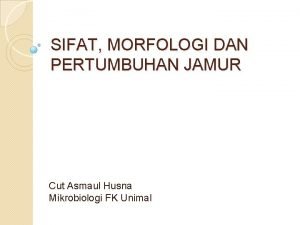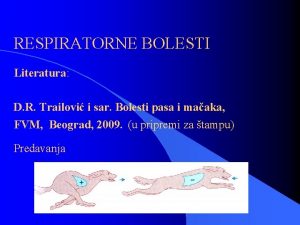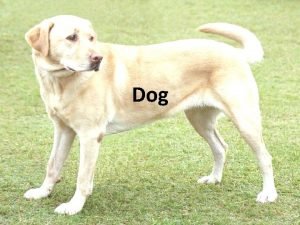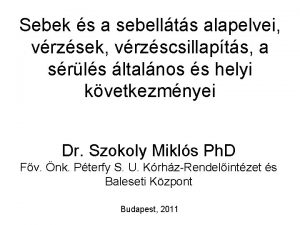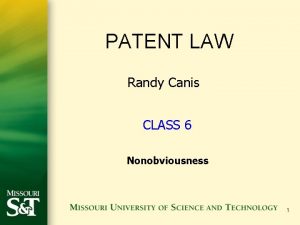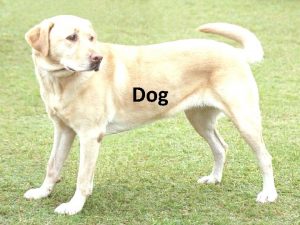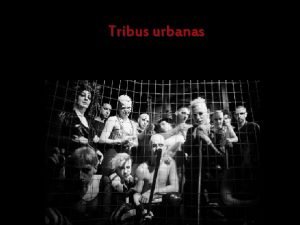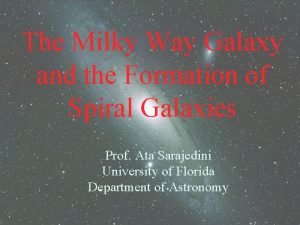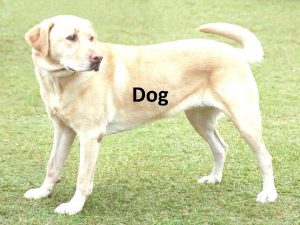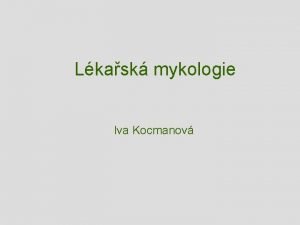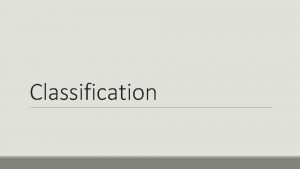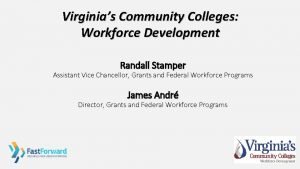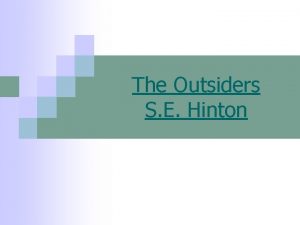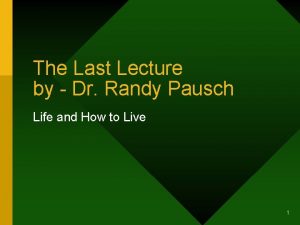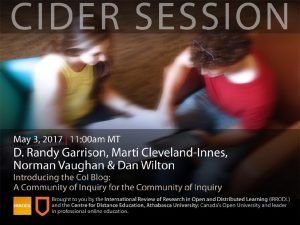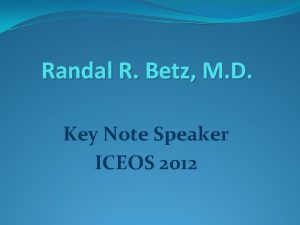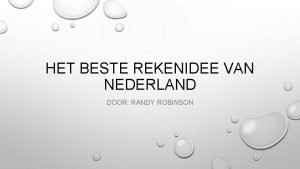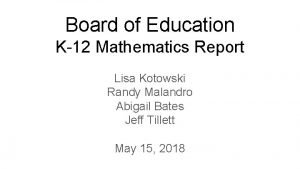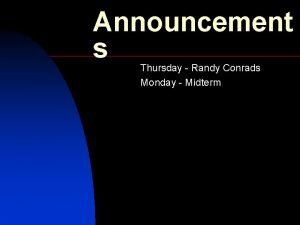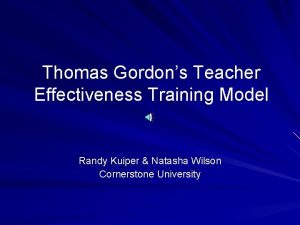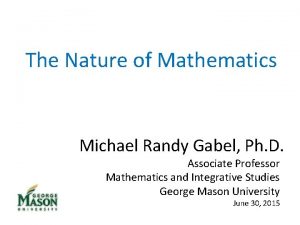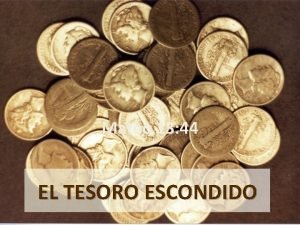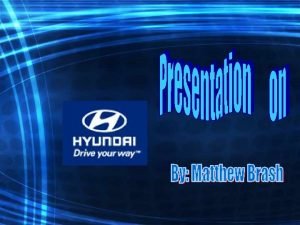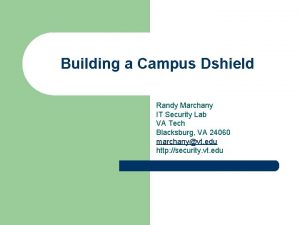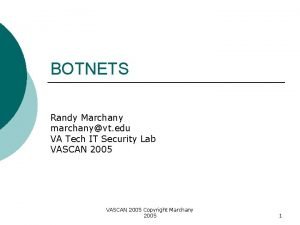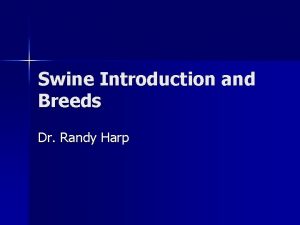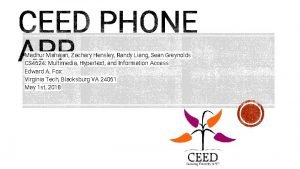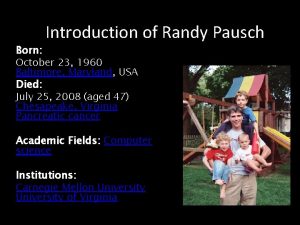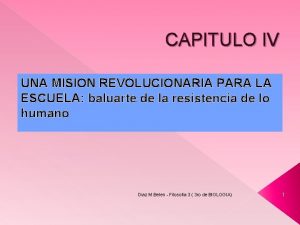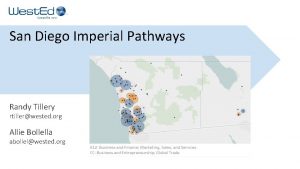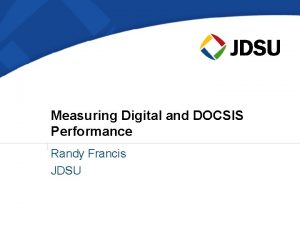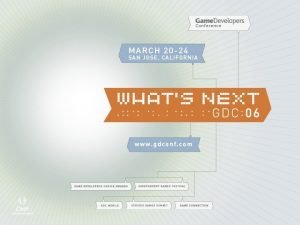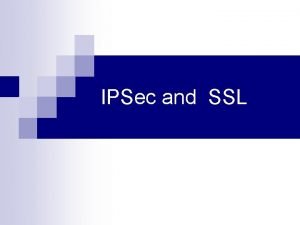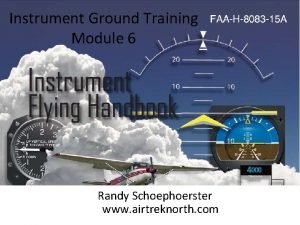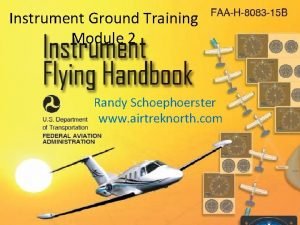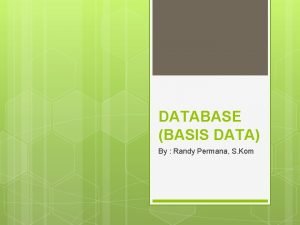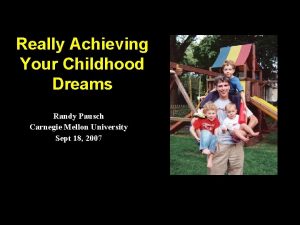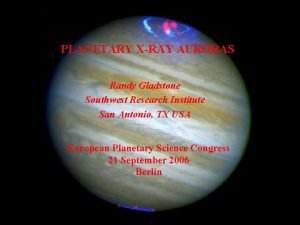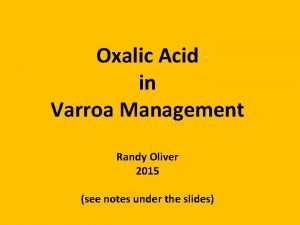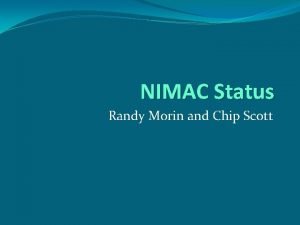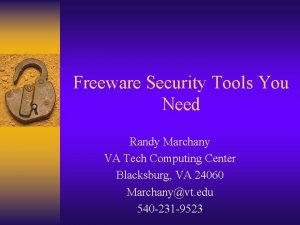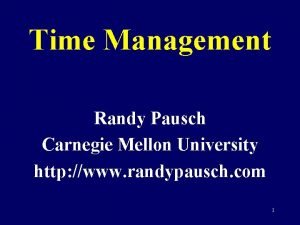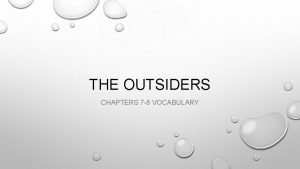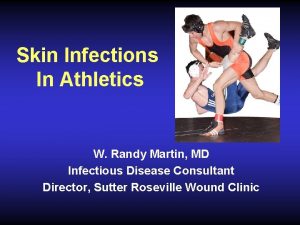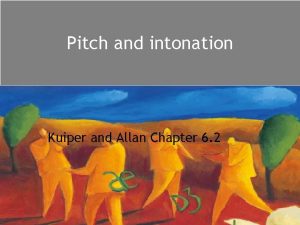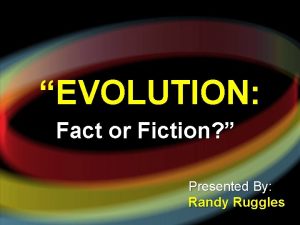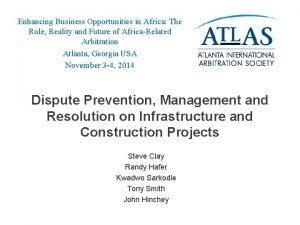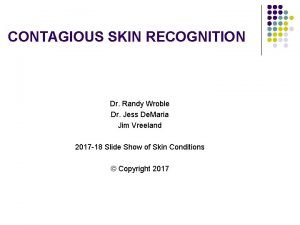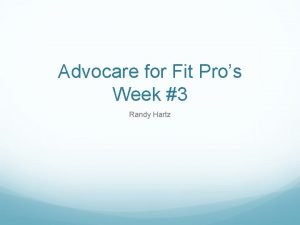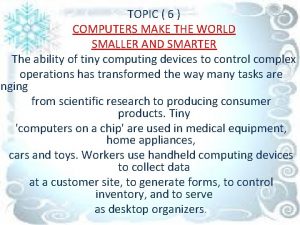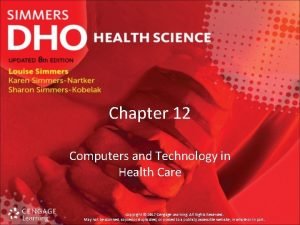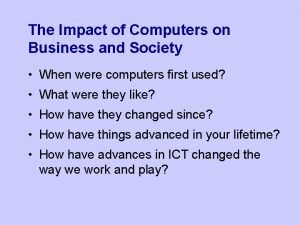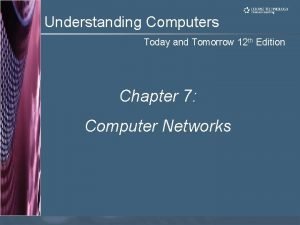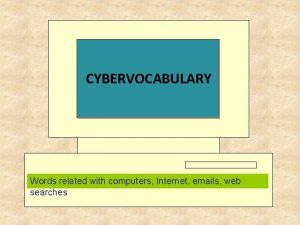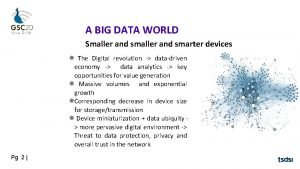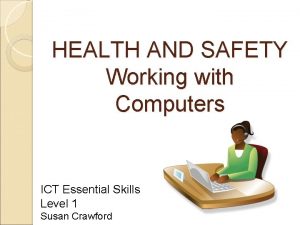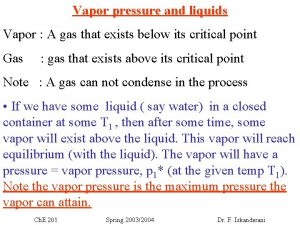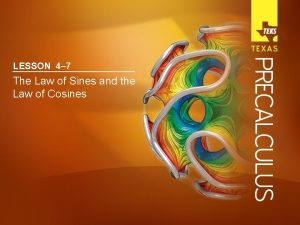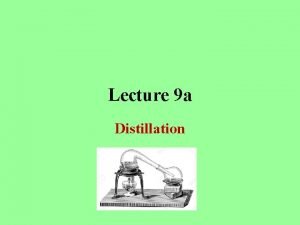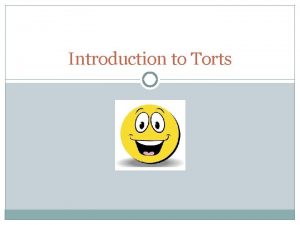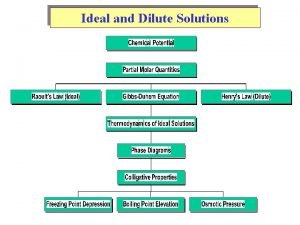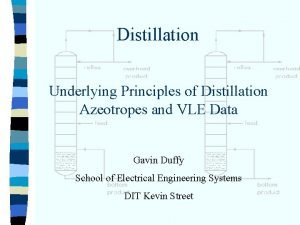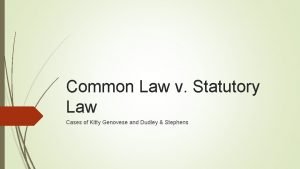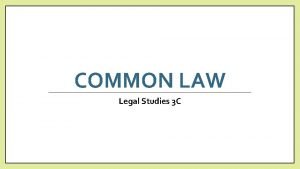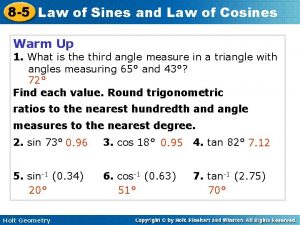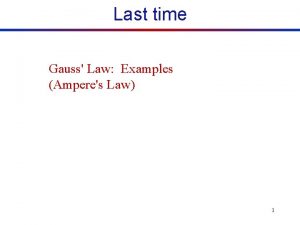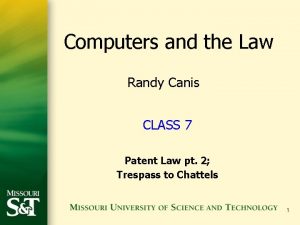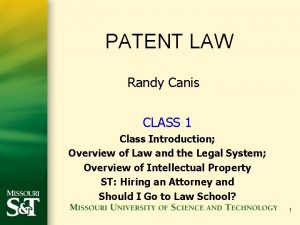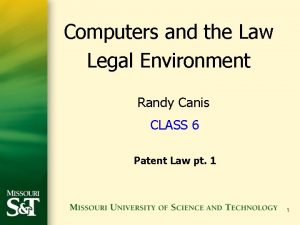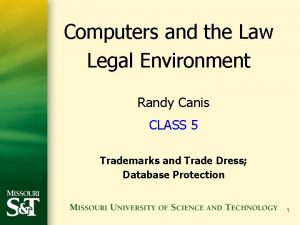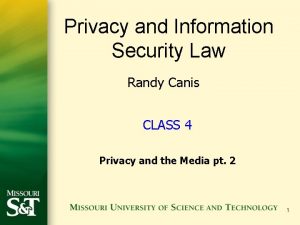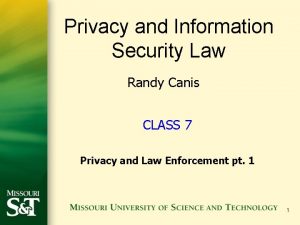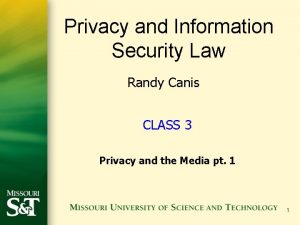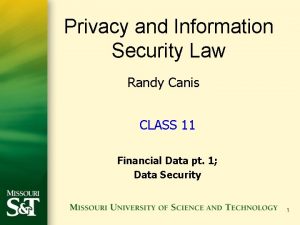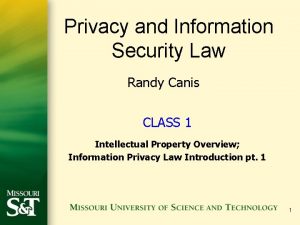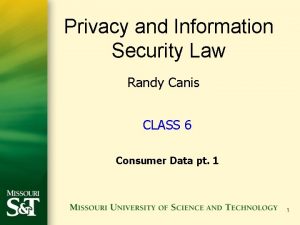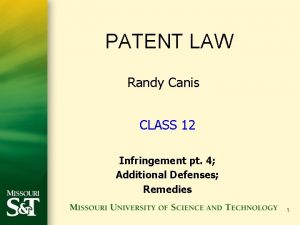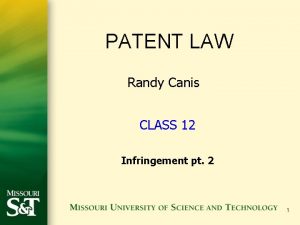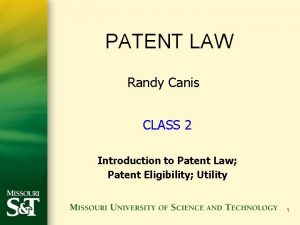Computers and the Law Randy Canis CLASS 14






























![Registration and Deposit • Registration: [§ 408] – Work can be registered at any Registration and Deposit • Registration: [§ 408] – Work can be registered at any](https://slidetodoc.com/presentation_image_h2/4fa71c89deabc7a2a4daf92ddf612746/image-31.jpg)
































![Feist Publications, Inc. v. Rural Telephone Service Co. • “[T]he copyright in a factual Feist Publications, Inc. v. Rural Telephone Service Co. • “[T]he copyright in a factual](https://slidetodoc.com/presentation_image_h2/4fa71c89deabc7a2a4daf92ddf612746/image-64.jpg)
















![Nonobviousness “[A]n invention must also sufficiently advance the useful arts in order to warrant Nonobviousness “[A]n invention must also sufficiently advance the useful arts in order to warrant](https://slidetodoc.com/presentation_image_h2/4fa71c89deabc7a2a4daf92ddf612746/image-81.jpg)





























![MGM v. Grokster Question addressed by Supreme Court: • “[U]nder what circumstances the distributor MGM v. Grokster Question addressed by Supreme Court: • “[U]nder what circumstances the distributor](https://slidetodoc.com/presentation_image_h2/4fa71c89deabc7a2a4daf92ddf612746/image-111.jpg)
![MGM v. Grokster Kiss of death • “… [The] business models employed by Grokster MGM v. Grokster Kiss of death • “… [The] business models employed by Grokster](https://slidetodoc.com/presentation_image_h2/4fa71c89deabc7a2a4daf92ddf612746/image-112.jpg)
![MGM v. Grokster Kiss of death • “… [The] business models employed by Grokster MGM v. Grokster Kiss of death • “… [The] business models employed by Grokster](https://slidetodoc.com/presentation_image_h2/4fa71c89deabc7a2a4daf92ddf612746/image-113.jpg)





























![1 -800 Contacts v. Lens. com • “[T]he Ninth Circuit considered ‘the labeling and 1 -800 Contacts v. Lens. com • “[T]he Ninth Circuit considered ‘the labeling and](https://slidetodoc.com/presentation_image_h2/4fa71c89deabc7a2a4daf92ddf612746/image-143.jpg)







- Slides: 150

Computers and the Law Randy Canis CLASS 14 Final Review 1

Final Exam 2

Final Exam Info • Final Exam format – 50 multiple choice questions – 2 points per question – All answers to be completed in Excel document provided on website – Use capital letters for your answer 3

Final Exam Info • Grading – I will not acknowledge receipt of your graded exam immediately. – However, I will respond within 24 hours of receipt of your exam with your final grade – I will not advise you of which questions you scored correctly or incorrectly on the final exam, nor do I send an answer key – However, if you did not receive the grade you expected to receive, I am willing to go over the questions with you that you missed. 4

Final Exam Info • Thus, you have an incentive to turn in the final exam early so that you can get your grade early and address any issues before your final exam grade is entered. • I reserve my right to enter final grades for all students at 12: 01 p. m. the day the exam is due. • DO NOT BE LATE IN TURNING IN THE EXAM OR, AMOUNG OTHER THINGS, YOUR GRADE IN THE COURSE COULD BE DELAYED • Any further questions about the final exam? 5

Final Review • What did we learn this semester? • Let’s review… 6

Class 1 • What did we learn? – Overview of Legal System – Understand the differences between different types of intellectual property • Skills – Understand the roles of the different branches of government – Properly identify and distinguish between different types of intellectual property 7

Branches of U. S. Government (3) Legislative Executive Judicial Body Congress Pres & Admin Agencies Federal Courts Role “Make” “Enforce” “Interpret” Regulations Case Opinions Federal Register and C. F. R. Case Reporters “Product” Statutes Location U. S. Code 88

Federal Court Structure • US Supreme Court (1) • US Court of Appeals (13) – 8 th Circuit – Federal Circuit • US District Courts (144); at least 1 per state – Missouri - 2 Federal District Courts • • • Eastern District - St. Louis Western District - Kansas City + Federal Bankruptcy Court 99

Types of Intellectual Property • Unfair Competition • Right of Publicity • Trademarks • Trade Secrets • Patent • Copyright Note: Lay people often erroneously term one type of intellectual property by another name, such as copyrighting a name, patenting a music CD, trademarking an invention, etc. 10 10

Class 2 • What did we learn? – Internet Jurisdiction – Trade Secrets • Skills – Understand meaning of jurisdiction and how it applies in cases – Understand different types of jurisdiction – Knowing the test for personal jurisdiction over the Internet – Understand what qualifies as a trade secret – Understand how to protect a trade secret 11

Jurisdictional Requirements • What is jurisdiction? – the power of a court to decide a matter in controversy (i. e. , a case) • What is needed to establish jurisdiction? – Authority of the court to hear the case (e. g. , original or appellate jurisdiction) – Authority of the court over the subject matter (subject matter jurisdiction) – Jurisdiction over the parties (personal jurisdiction) or property (in rem jurisdiction) of the suit – Proper notice 12

Power over Person or Property • Jurisdiction in personam – power which a court has over the defendant’s person and which is required before a court can enter a personal or in personam judgment. • Jurisdiction in rem – power of a court over a thing so that its judgment is valid as against the rights of every person in the thing Black’s Law Dictionary 13

Establishing Personal Jurisdiction over the Internet • Generally, courts view a defendant’s web site to determine whether jurisdiction based on sufficient contacts has been established. • Courts addressing web site passivity have found that creating a web site without more is not an act “purposefully directed at a forum state” sufficient to warrant the exercise of jurisdiction. • Courts look to the level of interactivity and commercial nature of the exchange of information that occurs on the web site to determine if sufficient contacts exist to warrant the exercise of jurisdiction. 14

Trade Secrets • What is a Trade Secret? – Generally speaking, a trade secret is any information that has not been published and that could give a company a competitive advantage • Is Trade Secret Law Protected by State or Federal Law? – Trade Secret law is protected by state law and varies from state to state • How about some good news? ! – Trade secrets are cheap (sort of); no filing fee but… – Duration – perpetual unless it is no longer a trade secret… 15

What are the Primary Categories of Trade Secrets? • The various categories of trade secrets include financial information, organization information, marketing information and technical information. • Financial information may include profit margins, overhead costs, material costs and supplier discounts. • Organizational information may include expansion plans, key employee acquisitions, record-keeping information and methods of operation. • Marketing information includes customer lists, terms of licenses, new product developments and contract negotiations. • Technical information includes formulas for producing products, computer software, chemical formulas and processes and methods of manufacture. 16

Brown v. Rollet Bros. Trucking Co. • Was the customer list a trade secret? • “Customer lists are protectable as trade secrets only when they represent ‘a selective accumulation of information based on past selling experience, or when considerable time and effort have gone into compiling it. ’ [] However, ‘'[t]o be protected, a customer list must be more than a listing of firms or individuals which could be compiled from directories or other generally available sources. ‘” 17

Avid. Air Helicopter Supply v. Rolls-Royce Corp. • “Reasonable efforts to maintain secrecy need not be overly extravagant, and absolute secrecy is not required. ” • “The use of proprietary legends on documents or the existence of confidentiality agreements are frequently -considered factors in establishing or denying a trade secret claim. ” 18

Class 3 • What did we learn? – Copyright • Skills – Know requirements for having a copyright – Understand how software (including video games) is protected by copyright – Understand benefits of copyright registration – Understand copyright term and notice requirements – Determine copyright ownership – Identify the type of work subject to copyright protection 19

Copyright Requirements • For an author to have a valid copyright in a particular work, the work must (i) be original, (ii) remain fixed in a tangible medium of expression, and (iii) have involved a minimum degree of creativity. 20

Originality • Must: – be an original work of the author – “a work independently created by its author, one not copied from pre-existing works, and a work that comes from the exercise of the creative powers of the author's mind, in other words, ‘the fruits of [the author's] intellectual labor. ’” • Artistic merits are irrelevant, • The underlying idea of a work is not subject to copyright protection. 21

Fixation • Works must be fixed in a tangible medium of expression to be protected under the Copyright Act. • Works must be embodied in a tangible form that is “sufficiently permanent or stable to permit it to be perceived, reproduced, or otherwise communicated for a period of more than transitory duration. ” • The requirement for fixation is met when the work can either be directly perceived or perceived with the aid of a machine or other device. 22

Protection of Literal Elements of Code • Are literal elements of the code subject to copyright protection? – Code itself is eligible subject matter and subject to copyright protection • Source code or object code? – Both 23

Abstraction. Filtration-Comparison Test • Step 1 - Separate protectable expression from unprotected ideas • Step 2 - Filter out elements of the program which are unprotectable • Step 3 - Compare the remaining protectable elements of the infringed program to the corresponding elements of the allegedly infringing program to determine whethere was sufficient copying of protected material to constitute infringement.

Lotus Development Corp. v. Borland International • 17 U. S. C. § 102(b) • “In no case does copyright protection for an original work of authorship extend to any idea, procedure, process, system, method of operation, concept, principle, or discovery, regardless of the form in which it is described, explained, illustrated, or embodied in such work. ” 25

Lotus Development Corp. v. Borland International • The court holds that the Lotus menu command hierarchy is an uncopyrightable method of operation. – The hierarchy is a method by which the program is operated and controlled – The expression is not copyrightable because it is part of the “method of operation” 26

Mitek Holdings, Inc. v. Arce Engineering Co. , Inc. • Insignificant portions copied – “[T]he elements that were considered original and appropriated were not of such significance to the overall program to warrant an ultimate finding of substantial similarity and hence infringement. ” 27

Protection for Program Outputs • Protection of screen displays are available as an audio-visual work 28

Video Games • What portions of a video game could be subject to copyright protection? – Game as a whole? – Elements of the game? – Game characters? – Incidents, characters, and/or settings relating to the game theme? 29

Incredible Technologies, Inc. v. Virtual Technologies, Inc. • Scenes a faire doctrine – “The doctrine refers to ‘incidents, characters or settings which are as a practical matter indispensable, or at least standard, in the treatment of a given topic. ’ These devices are not protectible by copyright. … For instance, the mazes, tunnels, and scoring tables in Atari's PAC-MAN were scenes a faire. ” 30
![Registration and Deposit Registration 408 Work can be registered at any Registration and Deposit • Registration: [§ 408] – Work can be registered at any](https://slidetodoc.com/presentation_image_h2/4fa71c89deabc7a2a4daf92ddf612746/image-31.jpg)
Registration and Deposit • Registration: [§ 408] – Work can be registered at any time [§ 408(a)] – Not a prerequisite to copyright protection [§ 408] – U. S. authors must register before bringing infringement suit [§ 411(a)] – Creates prima facie presumption of validity [§ 410(c)] • Deposit: [§ 407] – 2 complete copies of best edition must be deposited in Library of Congress within 3 months of first publication – Not a prerequisite to copyright protection [§ 407(a)] • Penalty: $ 250 + retail price of undeposited work • Sega's certificates of registration establish a prima facie valid copyright in its video game programs. 17 U. S. C. s 410(c); Apple Computer, Inc. v. Formula Int'l Inc. , 725 F. 2 d 521, 523 (9 th Cir. 1984). Sega Enterprises Ltd. v. MAPHIA, 857 F. Supp. 679, (N. D. Cal. 1994) 31

Term • What is the term of a copyright registration? – Life of the Author + 70 years – For anonymous works, pseudonymous works, and works made for hire - 95 years from publication or 120 years from creation, whichever expires first 32

Current Notice Requirements • Copyright notice no longer required… • Proper copyright notice: – (i) the symbol © (the letter C in a circle), or the word “Copyright”, or the abbreviation “Copr. ”, – (ii) the year of first publication of the work, and – (iii) the name of the owner of the copyright in the work. • Why still include the notice? 33

Copyright Registration • Computer Software – Form TX – Fee $35 (online)/$65 (paper) – No trade secrets • first 25 and last 25 pages of source code – With trade secrets • First 25 and last 25 pages of source code with portions containing trade secrets blocked out; or • First 10 and last 10 pages of source code alone, with no blocked out portions; or • First 25 and last 25 pages of object code plus any 10 or more consecutive pages of source code, with no blocked out portions; or • For programs 50 pages or less in length, entire source code with trade secret portions blocked out. 34

Ownership • General Rule – Copyright ownership vests with the author(s) of the work – Copyright ownership of a work can be assigned to another – Important exception – work made for hire 35

Work Made For Hire Employees • Within the Scope of Employment – the work is deemed authored by the employer and the employer will have all exclusive rights associated with the work. • Outside the Scope of Employment – the work is deemed authored by the employee and the employer will simply have a license to use the particular embodiment of the work without the exclusive rights associated with the work 36

Work Made For Hire Non-Employees • The work must be: 1. specially ordered or commissioned, 2. for use as a contribution to a collective work, as a part of a motion picture or other audiovisual work, as a translation, as a supplementary work, as a compilation, as an instructional text, as a test, as answer material for a test, or as an atlas, and 3. in a written instrument signed by the parties that states the work shall be considered a work made for hire. 37

Types of Works • • Derivative Work Joint Work Composite Work Compilation 38

Class 4 • What did we learn? – More copyright – Parody • Skills – Understand exclusive rights afforded by copyright protection and their exceptions – Understand copyright infringement and associated remedies – Understand fair use and its application – Identify what qualifies as a parody 39

EXCLUSIVE RIGHTS • • § 106. Exclusive rights in copyrighted works Subject to sections 107 through 121, the owner of copyright under this title has the exclusive rights to do and to authorize any of the following: (1) to reproduce the copyrighted work in copies or phonorecords; (2) to prepare derivative works based upon the copyrighted work; (3) to distribute copies or phonorecords of the copyrighted work to the public by sale or other transfer of ownership, or by rental, lease, or lending; (4) in the case of literary, musical, dramatic, and choreographic works, pantomimes, and motion pictures and other audiovisual works, to perform the copyrighted work publicly; (5) in the case of literary, musical, dramatic, and choreographic works, pantomimes, and pictorial, graphic, or sculptural works, including the individual images of a motion picture or other audiovisual work, to display the copyrighted work publicly; and (6) in the case of sound recordings, to perform the copyrighted work publicly by means of a digital audio transmission. 40

First Sale Doctrine • “The whole point of the first sale doctrine is that once the copyright owner places a copyrighted item in the stream of commerce by selling it, he has exhausted his exclusive statutory right to control its distribution. ” Quality King Distributors, Inc. v. L'anza Research Int'l, Inc, 523 U. S. 135, 152 (1998) 41

17 U. S. C. § 117 • (a) Making of Additional Copy or Adaptation by Owner of Copy. — Notwithstanding the provisions of section 106, it is not an infringement for the owner of a copy of a computer program to make or authorize the making of another copy or adaptation of that computer program provided: • (1) that such a new copy or adaptation is created as an essential step in the utilization of the computer program in conjunction with a machine and that it is used in no other manner, or • (2) that such new copy or adaptation is for archival purposes only and that all archival copies are destroyed in the event that continued possession of the computer program should cease to be rightful. 42

Copyright Infringement • A person commits copyright infringement when he/she violates any one of the author’s exclusive rights. • Infringement may be for intentional and unintentional acts • Possibility of injunction and actual or statutory damages • Statute of limitations for civil action – 3 years 43

Test for Infringement • A plaintiff bringing a claim for copyright infringement must demonstrate (1) ownership of a valid copyright, and (2) copying of constituent elements of the work that are original. • Absent evidence of direct copying, proof of infringement involves fact-based showings that the defendant had access to the plaintiff's work and that the two works are substantially similar. 44

Statutory Damages • (1) Except as provided by clause (2) of this subsection, the copyright owner may elect, at any time before final judgment is rendered, to recover, instead of actual damages and profits, an award of statutory damages for all infringements involved in the action, with respect to any one work, for which any one infringer is liable individually, or for which any two or more infringers are liable jointly and severally, in a sum of not less than $750 or more than $30, 000 as the court considers just. For the purposes of this subsection, all the parts of a compilation or derivative work constitute one work. 45

Fair Use • • • § 107. Limitations on exclusive rights: Fair use Notwithstanding the provisions of sections 106 and 106 A, the fair use of a copyrighted work, including such use by reproduction in copies or phonorecords or by any other means specified by that section, for purposes such as criticism, comment, news reporting, teaching (including multiple copies for classroom use), scholarship, or research, is not an infringement of copyright. In determining whether the use made of a work in any particular case is a fair use the factors to be considered shall include — – (1) the purpose and character of the use, including whether such use is of a commercial nature or is for nonprofit educational purposes; – (2) the nature of the copyrighted work; – (3) the amount and substantiality of the portion used in relation to the copyrighted work as a whole; and – (4) the effect of the use upon the potential market for or value of the copyrighted work. The fact that a work is unpublished shall not itself bar a finding of fair use if such finding is made upon consideration of all the above factors. 46

Sega Enterprises Ltd. v. Accolade, Inc. • Holding • “Because … disassembly is the only means for gaining access to those unprotected aspects of the program, and … [w]here there is a good reason for studying or examining the unprotected aspects of a copyrighted computer program, disassembly for purposes of such study or examination constitutes a fair use. ” • What is the public policy arguments behind the court’s decision? 47

Dr Seuss v. Penguin Books • D. C. – grant of preliminary injunction • Parody Analysis • “Parody is regarded as a form of social and literary criticism, having a socially significant value as free speech under the First Amendment. This court has adopted the "conjure up" test where the parodist is permitted a fair use of a copyrighted work if it takes no more than is necessary to "recall" or "conjure up" the object of his parody. ” 48

Leibovitz v. Paramount Pictures • “The focus of this inquiry, the Court explained, should be on whether the copying work "merely `supersede[s] the objects' of the original. . . , or instead adds something new, with a further purpose or different character, altering the first with new expression, meaning, or message, …” 49

Class 5 • What did we learn? – Trademarks and trade dress – Semiconductor protection – Database protection • Skills – – – – Know requirements for having trademark protection Distinguish between different types of trademarks Distinguish between the different types of trademark searches Assess trademark strength Understand trademark infringement and associated remedies Understand trade dress basics Understand what qualifies as a mask work and how it is protected – Understand what qualifies for database protection and how it is protected 50

What is a Trademark? • A trademark is any word, name, symbol, or device, or any combination thereof used to identify and distinguish his or her goods from those manufactured or sold by others and to indicate the source of the goods. • See 15 U. S. C. § 1127 51

Other Types of Marks • Service mark – “to identify and distinguish the services of one person … from the services of others and to indicate the source of the services” • Certification Mark – “to certify regional or other origin, material, mode of manufacture, quality, accuracy, or other characteristics of such person's goods or services or that the work or labor on the goods or services was performed by members of a union or other organization. ” • Collective Mark - indicates membership in a union, an association, or other organization. 52

Trade Names Distinguished • A trade name (or commercial name) is any name used by a person to identify his or her business or vocation. • Contrasting examples: – Microsoft v. Microsoft Corporation – Yahoo v. Yahoo! Inc. – Adobe v. Adobe Systems Incorporated 53

Symbols • • ® - Federally registered Circle T - State registered TM - trademark at common law SM – service mark at common law 54

Use Required To qualify for trademark rights, the person must: (1) be using the trademark in commerce, or (2) have a bona fide intention to use the trademark in commerce and apply to register on the principal register established by this Act. “The term ‘use in commerce’ means the bona fide use of a mark in the ordinary course of trade, and not made merely to reserve a right in a mark. ” 55

Types of Searches • Knock-out – exact mark • Preliminary – identical and confusingly similar federal and state trademarks • Comprehensive – preliminary plus common law and the Internet 56

Distinctiveness • • • Classifications of trademarks are based upon the inherent distinctiveness of the mark Classifications include 1) generic; 2) descriptive; 3) suggestive; and 4) arbitrary or fanciful. Fanciful or arbitrary marks are eligible for protection without proof of secondary meaning and with ease of establishing infringement. 57

What is the Principal of Likelihood of Confusion? • "The general concept underlying the likelihood of confusion [test] is that the public believe that the mark's owner sponsored or otherwise approved the use of the trademark. " … Therefore, the court must examine the eight factors identified in Elby's Big Boy. • See Blockbuster Entertainment Group, Div. of Viacom, Inc. v. Laylco, Inc. , 869 F. Supp. 505, 509 (E. D. Mich. 1994) 58

Factors for Likelihood of Confusion • • • In Squirt. Co v. Seven-Up Co. , 628 F. 2 d 1086, 1091 (8 th Cir. 1990), we articulated the factors to be considered in evaluating a likelihood of confusion. These can be enumerated as: 1) the strength of the plaintiff's mark; 2) the similarity between the plaintiff's and defendant's marks; 3) the degree to which the allegedly infringing product competes with the plaintiff's goods; 4) the alleged infringer's intent to confuse the public; 5) the degree of care reasonably expected of potential customers, and 6) evidence of actual confusion. "We use [these factors] as a guide to determine whether a reasonable jury could find a likelihood of confusion. Factual disputes regarding a single factor are insufficient to support the reversal of summary judgment unless they tilt the entire balance in favor of such a finding. " Duluth News-Tribune v. Mesabi Publ'g Co. , 84 F. 3 d 1093, 1096 (8 th Cir. 1996). Davis v. Walt Disney Co. , 2005 U. S. App. LEXIS 26461 (8 th Cir. 2005) 59

What Remedies are Available for Trademark Infringement? • • Injunction against future infringement Net profits, damages, court costs No punitive damages or attorney’s fees Burden on defendant to prove production expenses Destruction of infringing articles Cancellation of registration of infringing mark Import ban against infringing articles 60

Trade Dress • “The total appearance and image of a product, including features such as size, texture, shape, color or color combinations, graphics, and even particular advertising and marketing techniques used to promote its sales … Duplication of the trade dress of another’s goods is actionable as passing off at common law and under the Trademark Act. 15 USC § 1125(a). Commercial prints and labels constituting key elements of trade dress may be protectible under the copyright laws as well. ” • Levin, Trade Dress Protection § 2: 1 citing Black’s Law Dictionary 61

Brooktree Corp. v. AMD What is a mask work? • A series of related images, however fixed and encoded a) having or representing the predetermined, three dimensional pattern of metallic, insulating, or semiconductor material present or removed from the layers of a semiconductor chip product; and b) in which series the relation of the images to one another is that each image has the pattern of the surface of one form of a semiconductor chip product. 62

Brooktree Corp. v. AMD What defense is available to a violation of the SCPA? • Reverse Engineering: • It is not an infringement of a registered mask work for: 1) 2) a person to reproduce the mask work solely for the purpose of teaching, analyzing, or evaluating the concepts or techniques embodied in the mask work or the circuitry, logic flow, or organization of the components used in the marks works; or a person who performs the analysis or evaluation described in paragraph (1) to incorporate the results of such conduct in an original mask work which is made to be distributed. 63
![Feist Publications Inc v Rural Telephone Service Co The copyright in a factual Feist Publications, Inc. v. Rural Telephone Service Co. • “[T]he copyright in a factual](https://slidetodoc.com/presentation_image_h2/4fa71c89deabc7a2a4daf92ddf612746/image-64.jpg)
Feist Publications, Inc. v. Rural Telephone Service Co. • “[T]he copyright in a factual compilation is thin. Notwithstanding a valid copyright, a subsequent compiler remains free to use the facts contained in another's publication to aid in preparing a competing work, so long as the competing work does not feature the same selection and arrangement. ” 64

Class 6 • What did we learn? – Patent Law • Skills – Understand what a patent is – Understand the requirements for obtaining a patent and being an inventor 65

Why Own a Patent? • Ownership of a patent gives the patent owner the right to exclude others from making, using, offering for sale, selling, or importing into the United States the invention claimed in the patent. • 35 U. S. C. 154(a)(1), MPEP 301 66

How Long Does a Patent Last? General Rule • 20 years from filing (starting from the date of issuance) 37 U. S. C. 154(a) Exceptions • If filed before June 8, 1995, 20 years from date of filing or 17 years from issue, whichever is longest • Time with a Provisional Application does not count against the term • Patent Term Adjustment for delays during patent prosecution 37 U. S. C. 154(b), MPEP 2730 67

Reduction to Practice • An inventor may reduce an invention to practice either constructively by the filing of a patent application or actually by building and testing a physical embodiment of the invention. • “[T]he act of filing the United States application has the legal effect of being, constructively at least, a simultaneous conception and reduction to practice of the invention. ” Yasuko Kawai v. Metlestics, 480 F. 2 d 880 68

General Requirements - Patent Eligibility/Utility Requirement – Patent Eligibility/Utility • Patent Eligibility - Must be eligible subject matter • Utility - The invention must have utility. • 35 USC § 101 - “Whoever invents or discovers any new and useful process, machine, manufacture, or composition of matter, or any new and useful improvement thereof, may obtain a patent therefor, subject to the conditions and requirements of this title” 69

In re Bilski • Test identified by In re Bilski – “A claimed process is surely patenteligible under § 101 if: (1) it is tied to a particular machine or apparatus, or (2) it transforms a particular article into a different state or thing. ” – Sole test for determining patent eligibility of a process under 101… 70

In re Bilski – Supreme Court Decision • Result – Computer software is still patentable – Business methods that don’t involve technology have a limited chance of being patentable – What about methods for treatment? 71

Utility • Should the claimed invention be useful for some practical purposes in and of itself, or should it be superior to known technologies? 72

Lowell v. Lewis • “All that the law requires is, that the invention should not be frivolous or injurious to the well-being, good policy, or sound morals of society. ” • The patent system is not looking for something better, but rather is just looking for something different. 73

General Requirements Anticipation Requirement – Anticipation • The inventor must have invented something new. • 35 USC § 102(a) – “A person shall be entitled to a patent unless … the invention was known or used by others in this country, or patented or described in a printed publication in this or a foreign country, before the invention thereof by the applicant for patent” 74

Anticipation • “If the claimed invention can be found within the ambit of a single prior art reference, then the invention has been anticipated. References may not be combined during this inquiry, nor may elements that are analogous to the disclosure of a reference be considered. ” 75

General Requirements for Patentability Requirement – Statutory Bar • 1 year public disclosure bar • 35 USC § 102(b) – “A person shall be entitled to a patent unless … the invention was patented or described in a printed publication in this or a foreign country or in public use or on sale in this country, more than one year prior to the date of the application for patent in the United States” 76

Experimental Use • As a general rule, an experimental use only negates a statutory bar when the inventor was testing claimed features of the invention. • Courts view the totality of the circumstances when determining whether an invention was on sale or in public use • The experimental use exception does not include market testing. 77

Netscape Communications v. Konrad • “On Sale” Test 1)The product must be the subject of a commercial offer for sale 2)The invention must be ready for patenting • Proof of reduction to practice before the critical date; or • Proof that prior to the critical date the inventor had prepared drawings or other descriptions of the invention that were sufficiently specific to enable a person skilled in the art to practice the invention 78

“On Sale” • What about sale of the rights to the patent before the critical date? 79

General Requirements Nonobviousness Requirement – Nonobviousness • The new combination of elements must not be obvious to one of skill in the art at the time of the invention. • 35 U. S. C. § 103(a) “A patent may not be obtained though the invention is not identically disclosed or described as set forth in section 102 of this title, if the differences between the subject matter sought to be patented and the prior art are such that the subject matter as a whole would have been obvious at the time the invention was made to a person having ordinary skill in the art to which said subject matter pertains. … 80
![Nonobviousness An invention must also sufficiently advance the useful arts in order to warrant Nonobviousness “[A]n invention must also sufficiently advance the useful arts in order to warrant](https://slidetodoc.com/presentation_image_h2/4fa71c89deabc7a2a4daf92ddf612746/image-81.jpg)
Nonobviousness “[A]n invention must also sufficiently advance the useful arts in order to warrant the award of an exclusive right. … In terms of obviousness, the new combination does not warrant a patent if, from the vantage point of one of ordinary skill in the art at the time of the invention, this new combination would have been obvious. ” 81

Patent Specification Requirements 35 U. S. C. § 112 requires that the Specification of a patent application must contain: (A) A written description of the invention; (B) The manner and process of making and using the invention (the enablement requirement); and (C) The best mode contemplated by the inventor of carrying out the invention. M. P. E. P. 2161 82

Elemental Claim Structure Three basic parts of a claim: 1) A preamble 2) A transition phrase 3) A body 83

Types of Design Patent Protection Available 1) Configuration of an article of manufacturer – Design of a scissors, a computer speaker, a bottle 2) Surface ornamentation for an article of manufacturer – Design included on surface of bottle 3) Configuration and surface ornamentation 84

Protection of GUI • GUIs may be protected as design patents so long as properly presented and claimed. • Icons must be shown as part of a three-dimensional article of manufacture (e. g. , a computer display) • The structure of form of the article of manufacturer (i. e. , a computer) does not have to be claimed, but must be disclosed • Thus, the claim should be directed to a computer screen, monitor, display plan, or a portion thereof to comply with 35 U. S. C. 171 85

Class 7 • What did we learn? – Trespass to Chattels – More patent law • Skills – Understand trespass to chattels and spyware – Understand patent application requirements – Understand patent infringement 86

Prosecution • The process of negotiation with the United States Patent and Trademark Office (USPTO) in an attempt to obtain issuance of a patent application. 87

Provisional versus Nonprovisional Provisional Nonprovisional • Smaller Filing fee • Larger Filing fee • Less preparation time • More preparation time • Can not amend • Amendments are possible • No claims required • Must have at least 1 claim • Examined • Not examined • More formal • Informal • Valid for only 1 year; • Application valid until abandoned or patent issued must timely file nonprovisional claiming priority 88

Publication of patent applications • 18 months after filing unless applicant requests otherwise upon filing & certifies has not & won’t be subject of an application filed in a foreign country • Provisional rights available to patentees to obtain reasonable royalties if others make, use, sell, or import inv. In the period betw. publication and grant • Applicant can consider if foreign counterparts will be sought after all, after non-publ. requiest (NPR). • If applicant then files foreign patent, must notify PTO in US application within 60 days & withdraw NPR. Application then is published ASAP • PRIOR ART effect for published appls --Sec. 102(e) 89

Important Right of Joint Inventors • "In the absence of an agreement to the contrary, each of the owners of patent may make, use, offer to sell, or sell the patented invention with the United States, or import [it], without the consent of and without accounting to the other owners. " [Section 262 of Patent Statutes (35 U. S. C. 262)] 90

Citation of Material to the USPTO • Each individual associated with the filing and prosecution of a patent application has a duty of candor and good faith in dealing with the Office, which includes a duty to disclose to the Office all information known to that individual to be material to patentability as defined in this section. • 37 C. F. R. § 1. 56(a) 91

Therasense, Inc. v. Becton, Dickinson & Co. , • “To prevail on a claim of inequitable conduct, the accused infringer must prove that the patentee acted with the specific intent to deceive the PTO. … A finding that the misrepresentation or omission amounts to gross negligence or negligence under a ‘should have known’ standard does not satisfy this intent requirement. ” 92

Infringement Inquiries • First Inquiry - Does a device or method literally infringe one or more claims of a patent? • Second Inquiry - Does a device or method infringe one or more claims of a patent under the doctrine of equivalents (DOE)? 93

Markman v. Westview Instruments, Inc. • “An infringement analysis entails two steps. The first step is determining the meaning and scope of the patent claims asserted to be infringed. The second step is comparing the properly constructed claims to the device accused of infringing. ” • “… [I]n a case tried to a jury, the court has the power and obligation to construe as a matter of law the meaning of language used in the patent claim. ” 94

Claim Construction • Intrinsic – Claims – Specification – Prosecution History • Extrinsic – Inventor testimony – Dictionaries – Learned treatises 95

Form of Patent Reform • H. R. 1249 Leahy-Smith America Invents Act or AIA – Status – Passed • Rules Implementing Passage of AIA – Status – Some rules are passed, others are still to be developed • Case Law – Status – To be developed 96

When Do the Provisions of AIA Go Into Effect? • • • Day of Enactment Sept 16, 2011 10 Days Sept 26, 2011 Oct 1, 2011 60 Days Nov 15, 2011 12 Months Sept 16, 2012 18 Months Mar 6, 2013 97

Day of Enactment • • • Reexamination transition for threshold Tax strategies are deemed within the prior art Best Mode Human organism prohibition Virtual Marking False Marking Venue Change OED Statute of Limitations Fee Setting Authority Establishment of micro-entity 98

Prioritized Examination • Track 1 – $4, 800 Examination fee (50% reduction for small entity) – Final disposition on average within 12 months from examination request grant – Must be filed by EFS-WEB – Max of 4 indep. and 30 total claims • What if you want to expedite an already filed patent application? 99

First-to-File • First-to-file with one year grace period • Prior public use or prior sale anywhere counts as prior art • U. S. patents and patent application publications are effective as of priority date—even if international 100

First-to-File • Focus is on a patent applicant's “effective filing date” and whether prior art existed before that date • Eliminates current Section 102(g), interferences, and questions of conception, diligence, reduction to practice, abandonment, suppression, and concealment. 101

e. Bay v. Bidder's Edge • Trespass to chattels "lies where an intentional interference with the possession of personal property has proximately cause injury. " … In order to prevail on a claim for trespass based on accessing a computer system, the plaintiff must establish: (1) defendant intentionally and without authorization interfered with plaintiff's possessory interest in the computer system; and (2) defendant's unauthorized use proximately resulted in damage to plaintiff. … • Here, e. Bay has presented evidence sufficient to establish a strong likelihood of proving both prongs and ultimately prevailing on the merits of its trespass claim. 102

Class 8 • What did we learn? – Digital Music • Skills – Determine implication of the Audio Home Recording Act – Understand legality of file swapping and file swapping services – Understand contributory and vicarious copyright infringement 103

RIAA v. Diamond Multimedia Systems Directly • “Under the plain meaning of the Act's definition of digital audio recording devices, computers (and their hard drives) are not digital audio recording devices because their ‘primary purpose’ is not to make digital audio copied recordings. … Unlike digital audio tape machines, for example, whose primary purpose is to make digital audio copied recordings, the primary purpose of a computer is to run various programs and to record the data necessary to run those programs and perform various tasks. ” 104

A&M Records v. Napster • The district court further determined that plaintiffs' exclusive rights under § 106 were violated: " here the evidence establishes that a majority of Napster users use the service to download and upload copyrighted music. . And by doing that, it constitutes--the uses constitute direct infringement of plaintiffs' musical compositions, recordings. " A&M Records, Inc. v. Napster, Inc. , Nos. 99 -5183, 00 -0074, 2000 WL 1009483, at *1 (N. D. Cal. July 26, 2000) (transcript of proceedings). • The district court also noted that "it is pretty much acknowledged. . . by Napster that this is infringement. " Id. We agree that plaintiffs have shown that Napster users infringe at least two of the copyright holders' exclusive rights: the rights of reproduction, § 106(1); and distribution, § 106(3). • Napster users who upload file names to the search index for others to copy violate plaintiffs' distribution rights. Napster users who download files containing copyrighted music violate plaintiffs' reproduction rights. 105

A&M Records v. Napster • Contributory copyright infringement – “one who, with knowledge of the infringing activity, induces, causes or materially contributes to the infringing conduct of another, may be held liable as a 'contributory’ infringer. ” 106

A&M Records v. Napster • Vicarious Copyright Infringement - is an "outgrowth" of respondeat superior … [and in] the context of copyright law, vicarious liability extends beyond an employer/employee relationship to cases in which a defendant "has the right and ability to supervise the infringing activity and also has a direct financial interest in such activities. ” • Before moving into this discussion, we note that Sony's "staple article of commerce" analysis has no application to Napster's potential liability for vicarious copyright infringement. • The "staple article of commerce" doctrine "provides a defense only to contributory infringement, not to vicarious infringement. 107

A&M Records v. Napster • The district court correctly determined that Napster had the right and ability to police its system and failed to exercise that right to prevent the exchange of copyrighted material. The district court, however, failed to recognize that the boundaries of the premises that Napster "controls and patrols" are limited. • Our review of the record requires us to accept the district court's conclusion that plaintiffs have demonstrated a likelihood of success on the merits of the vicarious copyright infringement claim. Napster's failure to police the system's "premises, " combined with a showing that Napster financially benefits from the continuing availability of infringing files on its system, leads to the imposition of vicarious liability. 108

MGM v. Grokster Contributory Copyright Infringement • Requirements 1) direct infringement by a primary infringer, [undisputed] 2) knowledge of the infringement, and 3) material contribution to the infringement. 109

MGM v. Grokster Knowledge • Staple Article of Commerce Doctrine • Defendant must show that the product was "capable of substantial" or "commercially significant noninfringing uses. " – Sony – Since the video tape recorder was capable of commercially significant noninfringing uses, constructive knowledge of the infringing activity could not be imputed from the fact that Sony knew the recorders, as a general matter, could be used for infringement. – Napster – “[I]f a defendant could show that its product was capable of substantial or commercially significant noninfringing uses, then constructive knowledge of the infringement could not be imputed. Rather, if substantial non-infringing use was shown, the copyright owner would be required to show that the defendant had reasonable knowledge of specific infringing files. …” 110
![MGM v Grokster Question addressed by Supreme Court Under what circumstances the distributor MGM v. Grokster Question addressed by Supreme Court: • “[U]nder what circumstances the distributor](https://slidetodoc.com/presentation_image_h2/4fa71c89deabc7a2a4daf92ddf612746/image-111.jpg)
MGM v. Grokster Question addressed by Supreme Court: • “[U]nder what circumstances the distributor of a product capable of both lawful and unlawful use is liable for acts of copyright infringement by third parties using the product”? 111
![MGM v Grokster Kiss of death The business models employed by Grokster MGM v. Grokster Kiss of death • “… [The] business models employed by Grokster](https://slidetodoc.com/presentation_image_h2/4fa71c89deabc7a2a4daf92ddf612746/image-112.jpg)
MGM v. Grokster Kiss of death • “… [The] business models employed by Grokster and Stream. Cast confirm that their principal object was use of their software to download copyrighted works. ” • What about monitoring and filtering? 112
![MGM v Grokster Kiss of death The business models employed by Grokster MGM v. Grokster Kiss of death • “… [The] business models employed by Grokster](https://slidetodoc.com/presentation_image_h2/4fa71c89deabc7a2a4daf92ddf612746/image-113.jpg)
MGM v. Grokster Kiss of death • “… [The] business models employed by Grokster and Stream. Cast confirm that their principal object was use of their software to download copyrighted works. ” • What about monitoring and filtering? 113

Class 10 • What did we learn? – Domain Names – Semiconductor Protection – Right of Publicity • Skills – Identify what is a domain name – Know how to determine if a domain name is available and determine ownership of a domain name – Understand domain name disputes and resolution techniques – Understand right of publicity and semiconduct protection 114

DOMAIN NAMES • A domain name is a string of characters acting as an Internet identifier that simplifies the Internet location of an entity’s web site, such as My. Website. com. • http: //www. yahoo. com is a uniform resource locator (URL) that includes a domain name, a server accessed at the domain name, and the protocol being used to access the domain name. 115

ESSENTIAL DEFINITIONS • Registrar – a company that sells available domain names to end consumers pursuant to its relationship with one or more domain name registries • Registry – an entity responsible for allocating unique domain names within a particular country code or top level domain • WHOIS record – a record that provides detailed information for a particular domain name, which typically includes a registrant and an administrative contact 116

DOMAIN NAME OWNERSHIP • The registrant is really the domain name owner, even if he/she/it is not the person using the domain name. • The administrative contact has the power to modify the domain name, including changing registrant information and accepting change of registrars. 117

OBTAINING A WHOIS RECORD • The WHOIS records for some domain name extensions (e. g. , . com and. net) are decentralized. • To obtain the WHOIS records for decentralized extensions, you may need to visit the registry to first identify the registrar associated with the domain name and then visit the registrar to obtain the WHOIS record. • To obtain the WHOIS records for centralized extensions (. us, . info, and. biz), visit the registry. • Several sites such as the WHOIS available at Network Solutions and ALLWhois. com contain a number of WHOIS records from a variety of registries and registrars. 118

DOMAIN NAME TERM SEARCH • Domain name term searches provide a listing of domain names in at least the major domain name extensions that contain the term searched. The search can be a useful tool for locating potentially conflicting domain names that may not be otherwise uncovered. • A key term or terms should be used to run one or more domain name term searches. In addition, variations and shortened versions of the terms should be used to locate domain names that have been registered with misspellings. Two services that may be used for domain name term searches are Whois. net (free, more limited) and Mark. Monitor. com (charge depending on plan, more advanced). 119

REVERSE WHOIS SEARCH • A reverse WHOIS search on a term of interest (e. g. , a trademark) may identify entities that have adopted the term as part of their entity name. Typically, a reverse WHOIS search is used to identify the domain names associated with a particular registrant. • However, there are some limitations on the ability to conduct reverse WHOIS searches. First, there are no free tools to perform reverse WHOIS searches. In addition, the searches may be performed on some outof-date and incomplete records. 120

The Anticybersquatting Consumer Protection Act • The ACPA provides a civil action in the U. S. court system against anyone who, with bad faith intent to profit, registers, traffics in or uses a domain name that is: – identical or confusingly similar to a mark that was distinctive when the domain name was registered; – identical, confusingly similar or dilutive of a mark that was famous when the domain name was registered; or – infringes marks and names protected by statute. • Results from Successful Action: Entities proceeding under the ACPA can gain ownership or force deletion of the disputed domain name, costs (attorney’s fees, filing fees, etc. ), damages and injunction. 121

The Uniform Domain Name Dispute Resolution Policy • The UDRP provides a mandatory administrative proceeding against a domain name registrant where the domain name is: – identical or confusingly similar to a mark in which the complainant has rights; – domain name registrant has no rights or legitimate interests in respect of domain name; and – the domain name has been registered and is being used in bad faith. • Results from Successful Action: Entities proceeding under the UDRP can only gain ownership or force deletion of the domain name. 122

New Extensions • New Extensions are coming • Must meet certain requirements • Companies paid 185 K to evaluate per extension • List of applied for domain names to date is available online • http: //newgtlds. icann. org/en/applicant s/customer-service/faqs-en 123

Brooktree Corp. v. AMD What defense is available to a violation of the SCPA? • Reverse Engineering: • It is not an infringement of a registered mask work for: 1) 2) a person to reproduce the mask work solely for the purpose of teaching, analyzing, or evaluating the concepts or techniques embodied in the mask work or the circuitry, logic flow, or organization of the components used in the marks works; or a person who performs the analysis or evaluation described in paragraph (1) to incorporate the results of such conduct in an original mask work which is made to be distributed. 124

Altera Corp. v. Clear Logic, Inc. • “The second mask work must not be ‘substantially identical to the original’ and as long as there is evidence of ‘substantial toil and investment’ in creating the second mask work, rather than ‘mere plagiarism’ the second chip will not ‘infringe the original chip, even if the layout of the two chips is, in substantial part, similar’”. • What did the jury find? 125

Right of Publicity in MO • “In Missouri, ‘the elements of a right of publicity action include: (1) That defendant used plaintiff's name as a symbol of his identity (2) without consent (3) and with the intent to obtain a commercial advantage. ’” C. B. C. Distribution and Marketing, Inc. v. Major League Baseball Advanced Media, L. P. , 505 F. 3 d 818 (8 th Cir. )

Class 11 • What did we learn? – DMCA • Skills – Understand what is the DMCA and how it protects underlying content – Understand how service providers may limit liability under the DMCA 127

Universal Studios v. Reimerdes • The DMCA contains two principal anticircumvention provisions. • The first, Section 1201(a)(1), governs "[t]he act of circumventing a technological protection measure put in place by a copyright owner to control access to a copyrighted work, " an act described by Congress as "the electronic equivalent of breaking into a locked room in order to obtain a copy of a book. " … • The second, Section 1201(a)(2), which is the focus of this case, "supplements the prohibition against the act of circumvention in paragraph (a)(1) with prohibitions on creating and making available certain technologies. . . developed or advertised to defeat technological protections against unauthorized access to a work. " • As defendants are accused here only of posting and linking to other sites posting De. CSS, and not of using it themselves to bypass plaintiffs' access controls, it is principally the second of the anticircumvention provisions that issue in this case. 128

Sony v. Game. Masters • “The Digital Millennium Copyright Act, among other things, prohibits distribution of any product or device which: • 1) is primarily designed or produced for the purpose of circumventing a technological measure (or a protection afforded by a technological measure) that effectively controls access to a system protected by a registered copyright or effectively protects a right of a copyright owner in a registered work or portion thereof; • 2) has only limited commercially significant purpose or use other than to circumvent such a technological measure (or protection afforded it); Or • 3) is marketed for use in circumventing such a technological measure (or protection afforded by it). 17 U. S. C. § 1201(a)(2)-(3) and (b)(1)-(2) ( Public Law 105 -304, October 28, 1998). ” 129

Prerequisites Designated Agent • CS 317 -ISP must have registered a designated agent with the Copyright Office pursuant to § 512(c)(2) to take advantage of the safe harbor for information residing on systems or networks at direction of users (i. e. , § 512(c)). We have reviewed the Service Provider Agent List at the Copyright Office and CS 317 -ISP is not listed. • Without designating an agent, CS 317 -ISP is unable to receive the exemption for information residing on systems or networks at direction of users with the present matter. However, as will be further explained below, this exemption is immaterial with respect to the present notice received from Net. PD as the notice relates to the exemption for transitory digital network communications (i. e. , § 512(a)). 130

Prerequisites CS 317 -ISP Must Have an Anti-Infringement Policy in Effect • For CS 317 -ISP to use the OCILLA exemptions, under § 512(i)(1)(A) it must have adopted and reasonably implemented “a policy that provides for the termination in appropriate circumstances of subscribers and account holders of the service provider's system or network who are repeat infringers. ” CS 317 -ISP has adopted an AUP policy that is located on its website at URL http: //www. umr. edu/~canisr/cs 317/svcterms. htm. We are unaware of how CS 317 -ISP informs its subscribers and account holders of its AUP. 131

Summary of the Safe Harbors • OCILLA provides safe harbors to ISPs in four distinct circumstances: transitory digital network communications (i. e. , 512(a)), system caching (i. e. , 512(b)), information residing on systems or networks at direction of users (i. e. , 512(c)), and information location tools (i. e. , 512(d)). It is not necessary to obtain all four safe harbors to avoid liability. • Rather, when the behavior of an ISP falls within a particular safe harbor, that behavior will be exempted harbor if the ISP meets the prerequisites for obtaining the safe harbor as well as the particular requirements of the specific safe harbor. • Below we review whether CS 317 -ISP’s behavior falls within any of the safe harbors and whether the safe harbors are met. 132

SAFE HARBOR 512(a): Transitory Digital Network Communications Safe Harbor is Met • CS 317 -ISP has met the necessary requirements of the transitory digital network communications exemption because it is a service provider, the material was transmitted through its system and the transmission is eligible. Therefore, CS 317 -ISP is not liable for monetary relief (including without limitation damages, costs and attorneys’ fees) for the actions taken by its subscriber while using Aimster. 133

SAFE HARBOR 512(b): System Caching Background • The second safe harbor (i. e. , 512(b)) is for “system caching” and limits the liability for copyright infringement of a service provider by reason of the immediate and temporary storage of material on a system or network controlled or operated by or for the service provider…” 134

SAFE HARBOR 512(c): Information Residing on Systems or Networks at Direction of Users • Background • The third and penultimate safe harbor (i. e. , 512(c)) limits the liability for copyright infringement for the storage of infringing material at the direction of a user on a system or network controlled by the service provider. 135

SAFE HARBOR 512(d): Information Location Tools Background • The fourth and final safe harbor (i. e. , 512(d)) is for “information location tools” and limits the liability for copyright infringement of a service provider by reason of it “referring or linking users to an online location containing infringing material or infringing activity, by using information location tools, including a directory, index, reference, pointer, or hypertext link. ” 136

Capitol Records, Inc. v. MP 3 Tunes • "Red Flag" Knowledge of Infringement • “Service providers can lose the protection of the DMCA safe harbors if they have actual or apparent (also called ‘red flag’) knowledge of infringing content. ” • Formal take down notices only, or internal and third-party communications regarding the content? 137

Class 12 • What did we learn? – Software Licensing • Skills 138

Pro. CD v. Zeidenberg • “Shrinkwrap licenses are enforceable unless their terms are objectionable on grounds applicable to contracts in general (for example, if they violate a rule of positive law, or if they are unconscionable). Because no one argues that the terms of the license at issue here are troublesome, we remand with instructions to enter judgment for the plaintiff. ”

Example Clauses • Discussion of example of clauses that are often times found in contracts – Choice of law – Time is of the essence – Force Majeure – Severability – Waiver 140

Class 13 • What did we learn? – Spyware – Computer Crimes – Metatags and Keywords • Skills – Understand spyware – Understand what types of behaviors qualify as a computer crime – Understand metatags and keywords 141

1 -800 Contacts v. Lens. com • “We must resolve whether the Lanham Act was violated by an advertiser’s use of keywords that resembled a competitor’s service mark. For the most part, we hold that there was no violation. ” 142
![1 800 Contacts v Lens com The Ninth Circuit considered the labeling and 1 -800 Contacts v. Lens. com • “[T]he Ninth Circuit considered ‘the labeling and](https://slidetodoc.com/presentation_image_h2/4fa71c89deabc7a2a4daf92ddf612746/image-143.jpg)
1 -800 Contacts v. Lens. com • “[T]he Ninth Circuit considered ‘the labeling and appearance of the advertisements and the surrounding context on the screen displaying the results page’ to be a critical factor in finding no likelihood of confusion in a case in which the alleged infringer used a competitor’s mark as a keyword. ” 143

U. S. v. Crow • • • “Crow claims that the allegation charged in count four of the indictment did not satisfy the minimum constitutional requirements because: (1) it failed to state an offense under 18 U. S. C. § 2251; and (2) it failed to state an essential element of the crime requiring that the person exploited through various means must be a "minor. " Crow, in challenging the sufficiency of the indictment, focuses on the indictment's phrase "a person whom the defendant believed was a 13 year old female. " He contends that the statute requires that the individual exploited or that the defendant attempted to exploit had to actually be a minor. ” “Crow contends that section 2251 should be interpreted to require the individual involved to actually be a minor female, and not merely a person believed to be a minor female. Crow asserts that the indictment is insufficient because the statutory language provides that the person must be a minor and the indictment fails to reflect the statute's intent. ” The rest of the case seems like a plea bargain gone bad… 144

Protected Computer • Section 1030(e)(2) defines protected computer as: a computer— (A) exclusively for the use of a financial institution or the United States Government, or, in the case of a computer not exclusively for such use, used by or for a financial institution or the United States Government and the conduct constituting the offense affects that use by or for the financial institution or the Government; or (B) which is used in or affecting interstate or foreign commerce or communication. . 145

Accessing a Computer and Obtaining Information 1030(a)(2) Summary (Misd. ) 1. Intentionally access a computer 2. without or in excess of authorization 3. obtain information 4. from financial records of financial institution or consumer reporting agency OR the U. S. government OR a protected computer 146

Damaging a Computer or Information Summary of (a)(5)(A) 1. Knowingly cause transmission of a program, information, code, or command 2. intentionally cause damage to protected computer without authorization 147

Damaging a Computer or Information Summary of (a)(5)(B) 1. Intentionally access a protected computer without authorization 2. recklessly cause damage 148

Any Questions? • See you for the final class next week… 149

Program Completed All course materials - Copyright 2000 -14 Randy L. Canis, Esq. 150
 Randy pittman
Randy pittman Randy canis
Randy canis Randy canis
Randy canis Randy canis
Randy canis Newton's first law and second law and third law
Newton's first law and second law and third law Newton's first law of motion
Newton's first law of motion Canis minor mythology
Canis minor mythology Murphy's law computers
Murphy's law computers Vy canis majoris hypernova
Vy canis majoris hypernova Cetacea canidae panacea ursidae primates
Cetacea canidae panacea ursidae primates Canis parturiens
Canis parturiens Treatment of canine distemper in dogs
Treatment of canine distemper in dogs Mollia cinguntur tenui praecordia libro
Mollia cinguntur tenui praecordia libro Canis donnezani
Canis donnezani Toenail fungus microscope
Toenail fungus microscope Febris infectiosa canis
Febris infectiosa canis Canis familiaris classification
Canis familiaris classification Vágott seb vérzéscsillapítás
Vágott seb vérzéscsillapítás Ortho canis
Ortho canis Sporangiospores
Sporangiospores Canis familiaris classification
Canis familiaris classification Lolailos tribu urbana
Lolailos tribu urbana Toksokaroza canis
Toksokaroza canis Closest galaxy to milky way
Closest galaxy to milky way Canis lupus familiaris classification
Canis lupus familiaris classification Microsporum canis
Microsporum canis Canis familiaria
Canis familiaria Canis latrans classification
Canis latrans classification Boyles law
Boyles law Avogadro's law constant
Avogadro's law constant Randy stamper
Randy stamper Time management randy pausch
Time management randy pausch Randy adderson personality
Randy adderson personality Randy pausch the last lecture summary
Randy pausch the last lecture summary Dr randy pausch
Dr randy pausch Randy garrison
Randy garrison Dr randal betz
Dr randal betz Randy robinson
Randy robinson Fundamentals of web development randy connolly ppt
Fundamentals of web development randy connolly ppt Fasstmath
Fasstmath Randy unger
Randy unger Randy conrads
Randy conrads Randy kuiper
Randy kuiper Randy gabel
Randy gabel Asccc leadership institute
Asccc leadership institute Randy oliver varroa
Randy oliver varroa El principio del tesoro randy alcorn pdf
El principio del tesoro randy alcorn pdf Clarington hyundai
Clarington hyundai Randy marchany
Randy marchany Randy marchany
Randy marchany Randy harp
Randy harp Pearson
Pearson Zachary hensley
Zachary hensley William shatner
William shatner Randy sparkman
Randy sparkman Randy tillery
Randy tillery Randy francis
Randy francis Level building for stealth gameplay
Level building for stealth gameplay Ssl protocol stack
Ssl protocol stack Randy schoephoerster
Randy schoephoerster Randy schoephoerster
Randy schoephoerster Randy smith ups
Randy smith ups Randy permana
Randy permana Peas porridge hot meaning
Peas porridge hot meaning Achieving your childhood dreams randy pausch
Achieving your childhood dreams randy pausch Randy huffman west virginia
Randy huffman west virginia Randy gladstone
Randy gladstone Randy oliver oxalic acid
Randy oliver oxalic acid Randy morin
Randy morin Randy hanzlick
Randy hanzlick If 99 was good enough
If 99 was good enough Randy marchany
Randy marchany Randy pausch time management slides
Randy pausch time management slides The outsiders vocabulary chapter 7
The outsiders vocabulary chapter 7 Randy martin md
Randy martin md Randy testicular cancer
Randy testicular cancer Randy kuiper
Randy kuiper Stanley miller
Stanley miller Randy hafer
Randy hafer Dr jess demaria
Dr jess demaria Randy hartz
Randy hartz Hình ảnh bộ gõ cơ thể búng tay
Hình ảnh bộ gõ cơ thể búng tay Lp html
Lp html Bổ thể
Bổ thể Tỉ lệ cơ thể trẻ em
Tỉ lệ cơ thể trẻ em Voi kéo gỗ như thế nào
Voi kéo gỗ như thế nào Tư thế worm breton là gì
Tư thế worm breton là gì Bài hát chúa yêu trần thế alleluia
Bài hát chúa yêu trần thế alleluia Môn thể thao bắt đầu bằng chữ đua
Môn thể thao bắt đầu bằng chữ đua Thế nào là hệ số cao nhất
Thế nào là hệ số cao nhất Các châu lục và đại dương trên thế giới
Các châu lục và đại dương trên thế giới Công thức tính độ biến thiên đông lượng
Công thức tính độ biến thiên đông lượng Trời xanh đây là của chúng ta thể thơ
Trời xanh đây là của chúng ta thể thơ Cách giải mật thư tọa độ
Cách giải mật thư tọa độ Phép trừ bù
Phép trừ bù độ dài liên kết
độ dài liên kết Các châu lục và đại dương trên thế giới
Các châu lục và đại dương trên thế giới Thể thơ truyền thống
Thể thơ truyền thống Quá trình desamine hóa có thể tạo ra
Quá trình desamine hóa có thể tạo ra Một số thể thơ truyền thống
Một số thể thơ truyền thống Cái miệng nó xinh thế chỉ nói điều hay thôi
Cái miệng nó xinh thế chỉ nói điều hay thôi Vẽ hình chiếu vuông góc của vật thể sau
Vẽ hình chiếu vuông góc của vật thể sau Thế nào là sự mỏi cơ
Thế nào là sự mỏi cơ đặc điểm cơ thể của người tối cổ
đặc điểm cơ thể của người tối cổ V cc cc
V cc cc Vẽ hình chiếu đứng bằng cạnh của vật thể
Vẽ hình chiếu đứng bằng cạnh của vật thể Phối cảnh
Phối cảnh Thẻ vin
Thẻ vin đại từ thay thế
đại từ thay thế điện thế nghỉ
điện thế nghỉ Tư thế ngồi viết
Tư thế ngồi viết Diễn thế sinh thái là
Diễn thế sinh thái là Dot
Dot Các số nguyên tố là gì
Các số nguyên tố là gì Tư thế ngồi viết
Tư thế ngồi viết Lời thề hippocrates
Lời thề hippocrates Thiếu nhi thế giới liên hoan
Thiếu nhi thế giới liên hoan ưu thế lai là gì
ưu thế lai là gì Sự nuôi và dạy con của hươu
Sự nuôi và dạy con của hươu Sự nuôi và dạy con của hổ
Sự nuôi và dạy con của hổ Hệ hô hấp
Hệ hô hấp Từ ngữ thể hiện lòng nhân hậu
Từ ngữ thể hiện lòng nhân hậu Thế nào là mạng điện lắp đặt kiểu nổi
Thế nào là mạng điện lắp đặt kiểu nổi Introduction to ooad
Introduction to ooad Difference between abstract class and concrete class
Difference between abstract class and concrete class 7 rights of medication administration in order
7 rights of medication administration in order Static class loading and dynamic class loading
Static class loading and dynamic class loading Computer make the world smaller and smarter
Computer make the world smaller and smarter Chapter 12 computers and technology in health care
Chapter 12 computers and technology in health care The impact of computers on society
The impact of computers on society Understanding computers today and tomorrow
Understanding computers today and tomorrow Control flow and data flow computers
Control flow and data flow computers Words related to computers
Words related to computers Chapter 1 introduction to computers and programming
Chapter 1 introduction to computers and programming Computers make the world smaller and smarter
Computers make the world smaller and smarter History of python
History of python Rsi ict
Rsi ict Chapter 1 introduction to computers and programming
Chapter 1 introduction to computers and programming Chapter 1 introduction to computers and programming
Chapter 1 introduction to computers and programming Raoult's law and dalton's law
Raoult's law and dalton's law What is a civil law
What is a civil law Law of sines sss
Law of sines sss Simple distillation vs fractional distillation
Simple distillation vs fractional distillation Criminal law plaintiff
Criminal law plaintiff Thermodynamics equations
Thermodynamics equations Relative volatility
Relative volatility Difference between statute and common law
Difference between statute and common law Precedent example
Precedent example 8-5 practice b law of sines and law of cosines
8-5 practice b law of sines and law of cosines Raoult's law and dalton's law
Raoult's law and dalton's law Are we getting
Are we getting

